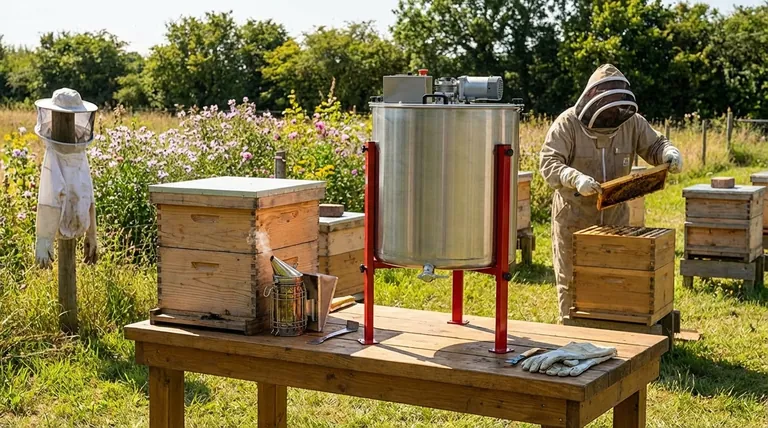To start beekeeping, you will need a complete beehive, personal protective gear like a veil and gloves, and a few essential tools, including a hive tool and a smoker. This core set of equipment is non-negotiable for safely managing the health and well-being of a honeybee colony.
The essential equipment for beekeeping can be divided into two distinct categories: what is necessary to care for the bees and what is necessary to harvest the honey. Understanding this distinction is the key to making smart initial investments based on your goals.

Core Equipment for Colony Health
Your first priority is providing a safe home and managing the colony effectively. This requires a standard set of tools that every beekeeper, regardless of scale, must have.
The Beehive
The hive is the bees' home and the center of your beekeeping world. A standard Langstroth hive consists of several stacked components: a bottom board, a deep hive body (or brood box) with frames for the queen to lay eggs, an inner cover, and a telescoping outer cover for weather protection.
Personal Protective Gear
Safety is paramount. A beekeeping veil is the absolute minimum to protect your face and neck. A full bee suit or jacket provides more comprehensive protection, and gloves designed for beekeeping protect your hands while allowing for dexterity.
Essential Hive Tools
You cannot effectively work a hive without two basic tools. A hive tool, which is a small crowbar, is used to pry apart frames and boxes sealed by the bees with propolis. A smoker is used to puff cool smoke into the hive, which calms the bees and makes inspections safer and easier.
Colony Support Tools
A bee brush is used to gently move bees off frames without harming them during inspections. Additionally, feeders are often necessary to provide sugar syrup to a new colony or to help a weak hive survive the winter when honey stores are low.
Equipment for Honey Harvesting
How you harvest honey is the biggest differentiator between a small-scale hobbyist and a more serious producer. The methods and equipment vary significantly in cost and efficiency.
The Hobbyist Method: Crush and Strain
For a beekeeper with only one or two hives, the simplest method is crush and strain. This involves mashing up the honeycomb and letting the honey drain through a sieve or filter. It requires no specialized equipment beyond basic kitchen tools.
The Scaled Method: Extraction
For those managing multiple hives, a honey extractor is a crucial investment. This machine uses centrifugal force to spin honey out of the frames without destroying the wax honeycomb. This is a massive advantage, as the bees can immediately refill the preserved comb instead of spending significant energy rebuilding it.
Supporting Harvest Tools
When using an extractor, you will also need a queen excluder. This is a screen placed between the brood box and the honey boxes (called supers) that prevents the larger queen from laying eggs where you want clean honey. An uncapping knife or fork is also used to remove the wax cappings from the honeycomb before extraction.
Understanding the Trade-offs
Your approach to equipment should be guided by a clear understanding of your budget and long-term goals.
Cost vs. Efficiency
The crush and strain method has a very low initial cost but is labor-intensive and destructive to the comb. An extractor is a significant upfront investment but saves immense time and, more importantly, preserves the honeycomb, boosting your hive's productivity year after year.
Phasing Your Purchases
You do not need honey harvesting equipment to start. A new beekeeper's focus should be entirely on establishing a healthy colony. You can delay the decision on whether to buy an extractor until you are confident you will have a honey surplus to harvest.
Making the Right Choice for Your Goal
Select your starting equipment based on the scale of your ambition.
- If your primary focus is a small-scale hobby (1-2 hives): Start with the core colony health equipment and plan to use the simple crush-and-strain method for your first harvest.
- If your primary focus is productivity and efficiency (3+ hives): Invest in a honey extractor and the associated tools from the beginning, as preserving the comb is critical to scaling your operation.
Ultimately, begin with the absolute essentials to keep your bees safe and healthy, and let your experience and success dictate your future equipment investments.
Summary Table:
| Category | Essential Equipment | Purpose |
|---|---|---|
| Colony Health | Beehive (Langstroth), Veil/Suit, Gloves, Hive Tool, Smoker | Safely house, manage, and protect the bee colony. |
| Honey Harvesting | Crush & Strain (Hobbyist) or Honey Extractor & Queen Excluder (Commercial) | Efficiently harvest honey while preserving wax comb for productivity. |
Ready to scale your beekeeping operation with professional-grade equipment?
HONESTBEE is your trusted wholesale partner, supplying durable and efficient beekeeping supplies to commercial apiaries and equipment distributors. We help you maximize productivity and protect your investment with gear designed for serious honey production.
Contact our experts today to discuss your wholesale needs and get a quote!
Visual Guide

Related Products
- Electric 8 Frame Honey Spinner Extractor Equipment for Beekeeping
- HONESTBEE 3-Frame Manual Acrylic Honey Extractor
- electric honey extractor honey centrifuge 3 frame honey extractor stainless steel honey frame extractor
- HONESTBEE 72 Frame Industrial Electric Honey Extractor for Beekeeping
- Stainless Steel 3 Frame Manual Honey Extractor Spinner for Bee Honey Extraction
People Also Ask
- What are the best storage conditions for a honey extractor? Protect Your Investment for Next Season
- What should be considered when harvesting honey from multiple hives? Scale Your Harvest Efficiently
- What are the differences between manual and electric honey extractors? A Beekeeper's Guide to Power, Speed & Cost
- Why is cleaning a honey extractor important in beekeeping? Protect Your Honey Quality & Equipment
- How long should you spin honey for? Master the Art of Efficient, Safe Extraction



















